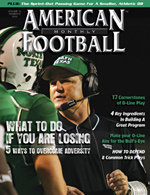Article CategoriesAFM Magazine
|
Coach to Coachby: Bryon HamiltonHead Coach, Foothill High School, Palo Cedro (CA) © More from this issue When I was an offensive coordinator at the junior/community college level for six seasons, my football life consisted of recruiting, installing our schemes, game planning and calling the game on Saturdays. A full plate for sure, but it was 100% football. I definitely had ideas of what I would do if and when I became a head coach, but all of the peripheral things associated with running the entire program were in the hands of the head coach and the athletic director. In those days I thought that I had an idea of what it took to run and build a successful program, but the reality was that I had no real idea. At the time of writing this article I am 4 games into my 8th season as the head coach at Foothill High School in Palo Cedro, California. Looking back at the last eight years, I can honestly say that there is a lot to building a succe....The full article can only be seen by subscribers.
|
|
|||||||
| HOME |
MAGAZINE |
SUBSCRIBE | ONLINE COLUMNISTS | COACHING VIDEOS |
Copyright 2026, AmericanFootballMonthly.com
All Rights Reserved





